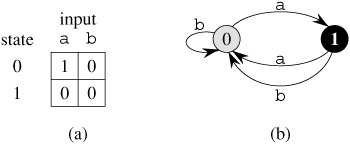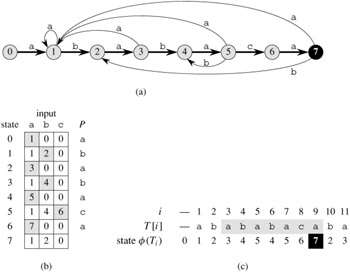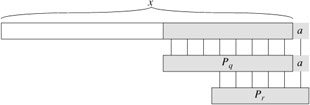| < Day Day Up > |
Many string-matching algorithms build a finite automaton that scans the text string T for all occurrences of the pattern P. This section presents a method for building such an automaton. These string-matching automata are very efficient: they examine each text character exactly once, taking constant time per text character. The matching time used-after preprocessing the pattern to build the automaton-is therefore Θ(n). The time to build the automaton, however, can be large if Σ is large. Section 32.4 describes a clever way around this problem.
We begin this section with the definition of a finite automaton. We then examine a special string-matching automaton and show how it can be used to find occurrences of a pattern in a text. This discussion includes details on how to simulate the behavior of a string-matching automaton on a given text. Finally, we shall show how to construct the string-matching automaton for a given input pattern.
A finite automaton M is a 5-tuple (Q, q0, A, Σ, δ), where
Q is a finite set of states,
q0 ∈ Q is the start state,
A ⊆ Q is a distinguished set of accepting states,
Σ is a finite input alphabet,
δ is a function from Q × Σ into Q, called the transition function of M.
The finite automaton begins in state q0 and reads the characters of its input string one at a time. If the automaton is in state q and reads input character a, it moves ("makes a transition") from state q to state δ(q, a). Whenever its current state q is a member of A, the machine M is said to have accepted the string read so far. An input that is not accepted is said to be rejected. Figure 32.6 illustrates these definitions with a simple two-state automaton.

A finite automaton M induces a function φ, called the final-state function, from Σ* to Q such that φ(w) is the state M ends up in after scanning the string w. Thus, M accepts a string w if and only if φ(w) ∈ A. The function φ is defined by the recursive relation
|
φ(ε) |
= |
q0, |
|
φ(wa) |
= |
δ(φ(w), a) for w ∈ Σ*, a ∈ Σ. |
There is a string-matching automaton for every pattern P; this automaton must be constructed from the pattern in a preprocessing step before it can be used to search the text string. Figure 32.7 illustrates this construction for the pattern P = ababaca. From now on, we shall assume that P is a given fixed patternstring; for brevity, we shall not indicate the dependence upon P in our notation.

In order to specify the string-matching automaton corresponding to a given pattern P[1 ‥ m], we first define an auxiliary function σ , called the suffix function corresponding to P. The function σ is a mapping from Σ* to {0, 1, . . . , m} such that σ(x) is the length of the longest prefix of P that is a suffix of x:
σ(x) = max {k : Pk ⊐ x}.
The suffix function σ is well defined since the empty string P0 = ε is a suffix of every string. As examples, for the pattern P = ab, we have σ(ε) = 0, σ(ccaca) = 1, and σ(ccab) = 2. For a pattern P of length m, we have σ(x) = m if and only if P ⊐ x. It follows from the definition of the suffix function that if x ⊐ y, then σ(x) ≤ σ(y).
We define the string-matching automaton that corresponds to a given pattern P[1 ‥ m] as follows.
The state set Q is {0, 1, . . . , m}. The start state q0 is state 0, and state m is the only accepting state.
The transition function δ is defined by the following equation, for any state q and character a:
Here is an intuitive rationale for defining δ(q, a) = σ(Pqa). The machine maintains as an invariant of its operation that
this result is proved as Theorem 32.4 below. In words, this means that after scanning the first i characters of the text string T , the machine is in state φ(Ti) = q, where q = σ(Ti) is the length of the longest suffix of Ti that is also a prefix of the pattern P. If the next character scanned is T [i + 1] = a, then the machine should make a transition to state σ(Ti+1) = σ(Tia). The proof of the theorem shows that σ(Tia) = σ(Pqa). That is, to compute the length of the longest suffix of Tia that is a prefix of P, we can compute the longest suffix of Pqa that is a prefix of P. At each state, the machine only needs to know the length of the longest prefix of P that is a suffix of what has been read so far. Therefore, setting δ(q, a) = σ(Pqa) maintains the desired invariant (32.4). This informal argument will be made rigorous shortly.
In the string-matching automaton of Figure 32.7, for example, δ(5, b) = 4. We make this transition because if the automaton reads a b in state q = 5, then Pq b = ababab, and the longest prefix of P that is also a suffix of ababab is P4 = abab.
To clarify the operation of a string-matching automaton, we now give a simple, efficient program for simulating the behavior of such an automaton (represented by its transition function δ) in finding occurrences of a pattern P of length m in an input text T [1 ‥ n]. As for any string-matching automaton for a pattern of length m, the state set Q is {0, 1, . . . , m}, the start state is 0, and the only accepting state is state m.
FINITE-AUTOMATON-MATCHER(T, δ, m) 1 n ← length[T] 2 q ← 0 3 for i ← 1 to n 4 do q ← δ(q, T[i]) 5 if q = m 6 then print "Pattern occurs with shift" i - m
The simple loop structure of FINITE-AUTOMATON-MATCHER implies that its matching time on a text string of length n is Θ(n). This matching time, however, does not include the preprocessing time required to compute the transition function δ. We address this problem later, after proving that the procedure FINITE-AUTOMATON-MATCHER operates correctly.
Consider the operation of the automaton on an input text T [1 ‥ n]. We shall prove that the automaton is in state σ(Ti) after scanning character T [i]. Since σ(Ti) = m if and only if P ⊐ Ti, the machine is in the accepting state m if and only if the pattern P has just been scanned. To prove this result, we make use of the following two lemmas about the suffix function σ.
For any string x and character a, we have σ(xa) ≤ σ(x) + 1.
Proof Referring to Figure 32.8, let r = σ(xa). If r = 0, then the conclusion σ(xa) = r ≤ σ(x) + 1 is trivially satisfied, by the nonnegativity of σ(x). So assume that r > 0. Now, Pr ⊐ xa, by the definition of σ. Thus, Pr-1 ⊐ x, by dropping the a from the end of Pr and from the end of xa. Therefore, r -1 ≤ σ(x), since σ(x) is largest k such that Pk ⊐ x, and σ(xa) = r ≤ σ(x) + 1.

For any string x and character a, if q = σ(x), then σ(xa) = σ(Pqa).
Proof From the definition of σ, we have Pq ⊐ x. As Figure 32.9 shows, we also have Pqa ⊐ xa. If we let r = σ (xa), then r ≤ q + 1 by Lemma 32.2. Since Pqa ⊐ xa, Pr ⊐ xa, and |Pr| ≤ |Pqa|, Lemma 32.1 implies that Pr ⊐ Pqa. Therefore, r ≤ σ(Pqa), that is, σ(xa) ≤ σ(Pqa). But we also have σ(Pqa) ≤ σ(xa), since Pqa ⊐ xa. Thus, σ(xa) = σ(Pqa).

We are now ready to prove our main theorem characterizing the behavior of a string-matching automaton on a given input text. As noted above, this theorem shows that the automaton is merely keeping track, at each step, of the longest prefix of the pattern that is a suffix of what has been read so far. In other words, the automaton maintains the invariant (32.4).
If φ is the final-state function of a string-matching automaton for a given pattern P and T[1 ‥ n] is an input text for the automaton, then
φ(Ti) = σ(Ti)
for i = 0, 1, . . . , n.
Proof The proof is by induction on i. For i = 0, the theorem is trivially true, since T0 = ε. Thus, φ(T0) = 0 = σ(T0).
Now, we assume that φ(Ti) = σ(Ti) and prove that φ(Ti+1) = σ(Ti+1). Let q denote φ(Ti), and let a denote T[i + 1]. Then,
|
φ(Ti+1) |
= |
φ(Tia) |
(by the definitions of Ti+1 and a) |
|
= |
δ(φ(Ti), a) |
(by the definition of φ) |
|
|
= |
δ(q, a) |
(by the definition of q) |
|
|
= |
σ(Pqa) |
(by the definition (32.3) of δ) |
|
|
= |
σ(Tia) |
(by Lemma 32.3 and induction) |
|
|
= |
σ(Ti+1) |
(by the definition of Ti+1). |
By Theorem 32.4, if the machine enters state q on line 4, then q is the largest value such that Pq ⊐ Ti. Thus, we have q = m on line 5 if and only if an occurrence of the pattern P has just been scanned. We conclude that FINITE-AUTOMATON-MATCHER operates correctly.
The following procedure computes the transition function δ from a given pattern P[1 ‥ m].
COMPUTE-TRANSITION-FUNCTION(P, Σ) 1 m ← length[P] 2 for q ← 0 to m 3 do for each character a ∈ Σ 4 do k ← min(m + 1, q + 2) 5 repeat k ← k - 1 6 until Pk ⊐ Pqa 7 δ(q, a) ← k 8 return δ
This procedure computes δ(q, a) in a straightforward manner according to its definition. The nested loops beginning on lines 2 and 3 consider all states q and characters a, and lines 4-7 set δ(q, a) to be the largest k such that Pk ⊐ Pqa. The code starts with the largest conceivable value of k, which is min(m, q + 1), and decreases k until Pk ⊐ Pqa.
The running time of COMPUTE-TRANSITION-FUNCTION is O(m3 |Σ|), because the outer loops contribute a factor of m |Σ|, the inner repeat loop can run at most m + 1 times, and the test Pk ⊐ Pqa on line 6 can require comparing up to m characters. Much faster procedures exist; the time required to compute δ from P can be improved to O(m |Σ|) by utilizing some cleverly computed information about the pattern P (see Exercise 32.4-6). With this improved procedure for computing δ, we can find all occurrences of a length-m pattern in a length-n text over an alphabet Σ with O(m |Σ|) preprocessing time and Θ(n) matching time.
Construct the string-matching automaton for the pattern P = aabab and illustrate its operation on the text string T = aaababaabaababaab.
Draw a state-transition diagram for a string-matching automaton for the pattern ababbabbababbababbabb over the alphabet Σ = {a, b}.
We call a pattern P nonoverlappable if Pk ⊐ Pq implies k = 0 or k = q. Describe the state-transition diagram of the string-matching automaton for a nonoverlappable pattern.
Given two patterns P and P′, describe how to construct a finite automaton that determines all occurrences of either pattern. Try to minimize the number of states in your automaton.
Given a pattern P containing gap characters (see Exercise 32.1-4), show how to build a finite automaton that can find an occurrence of P in a text T in O(n) matching time, where n = |T|.
| < Day Day Up > |